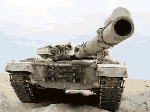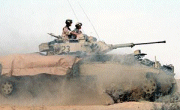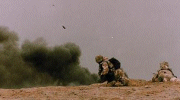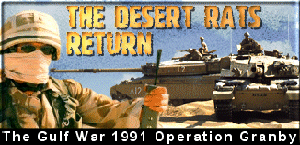Desert Storm: The Land War
On 24th February, at 1 am GMT. Just before dawn in the Gulf, the army of the 28-nation alliance rolled into Kuwait and Iraq.

Challenger Tank
The Allied attack came under a news blackout as coalition forces, wearing full chemical protective gear, broke through Iraqi sand barriers with giant bulldozers to create an invasion alley. Challenger tanks of Britain's' 4th and 7th Armoured brigades raced through minefields 60 miles into Iraq with orders to seek and destroy the Republican Guards Soviet-built T72 tanks around Basra, Iraqis' second largest city. The 8,000 men had been taking anti-nerve and anti-anthrax pills for days, knew they had the most dangerous mission of the war. Alongside them were French Legionnaires and the US 7th Army with its Abrams. The British commanders were in the turrets of their own tanks, in amongst the charge.
Behind the lines of the Iraqi army small teams of SAS and US Special forces 'spiked' their pre-arranged targets for the continuing air strikes with laser-markers. At sea, British minesweepers cleared the way for the World last active battleships to the Kuwait coast form where the USS Wisconsin and Missouri pounded Iraqi positions on the coast, reinforcing the Iraqi belief that an amphibious landing was imminent.

The honour of being first across the border went to the remnants of the Kuwait army as they advanced, backed by US Marines, straight into Kuwait City. In just 10 hours the Allied army conquered territory it was thought would take days to take. ten thousand Iraqi prisoners were quickly taken and thousands more, dazed and battered after 38 days of aerial bombardment streamed from their sand holes carrying white flags. In Kuwait, retreating Iraqi created the worst environmental disaster seen in the gulf as they set fire to the vast oil fields of Kuwait. That evening an Iraqi scud attack killed 28 American soldiers and wounded scores more at Dhahran.
As the United Nations again tried for a peaceful solution, the Desert Rats slammed into the Iraqi Republican Guard. Thirty five of their tanks were destroyed in Southern Iraq, and 80 others fled south to avoid the British closing in behind them. American paratroops of the 101st Airborne joined the attack after being landed by Helicopters of the Allied air forces.

The end of Day two of the land war, saw the Desert Rats sweeping deeper into Iraq and towards the Euphrates river. The pride of Saddam's army was virtually cut off. French troops forced their way 100 miles into Iraq, capturing 3,000 men and severing supply and communication lines to the Guards. Over 300 Iraqi tanks had been destroyed, one every six minutes and the Allied encircled Kuwait City. At Sea, The H.M.S. Gloucester, spotted an Iraqi Silkworm missile heading for the Battleship USS Missouri, and shot it down with seconds to spare.
The Allies liberated Kuwait City as the Iraqis fled in disarray. It was the end of 207 days of Occupation. As the Iraqi Army fled, the worst incident of the entire war occurred. A US A-10 Warthog 'tank-busting' ground-attack aircraft fired armour piercing shells at two British Warrior infantry fighting vehicles. Nine British soldiers of the 4th Armoured Brigade died. See Roll Of Honour.
The Allies ceased their pursuit of the Iraqi army 100 hours after it began, at 2am on Thursday 28th February the American George Bush announced that he called a ceasefire. The toll of the land war was high, At least 100,000 Iraqi soldiers had been killed. More than 175,000 were Prisoners of war. The Allied death toll was 126 killed in Action including 17 britons and 79 Americans.
The Iraqi generals surrendered officially, on Monday 3rd March at an airfield in Safwan, Southern Iraq. Within a couple of days, the captured Allied airmen, Special forces troops and Allied civilians were released from Iraqi custody.



